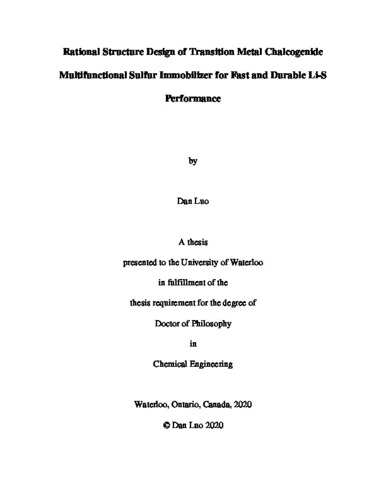UWSpace will be migrating to a new version of its software from July 29th to August 1st. UWSpace will be offline for all UW community members during this time.
Rational Structure Design of Transition Metal Chalcogenide Multifunctional Sulfur Immobilizer for Fast and Durable Li-S Performance
| dc.contributor.author | Luo, Dan | |
| dc.date.accessioned | 2020-08-12 20:07:16 (GMT) | |
| dc.date.available | 2020-08-12 20:07:16 (GMT) | |
| dc.date.issued | 2020-08-12 | |
| dc.date.submitted | 2020-08-06 | |
| dc.identifier.uri | http://hdl.handle.net/10012/16117 | |
| dc.description.abstract | Lithium-sulfur (Li-S) batteries are one of the most promising candidates for next-generation energy storage owing to their high energy density, environmental benignity and cost effectiveness. However, the practical application of Li-S batteries is still hindered by technical challenges, including the insulating nature of sulfur, the sluggish redox reaction kinetics and notorious polysulfide shuttle effect. Rational design of sulfur electrode is significant to improving Li-S performance, among which the morphology control, defect engineering and ultrafine structure implantation in the design of multifunctional sulfur immobilizer holds a great potential in altering the physical and electrochemical features toward fast and durable sulfur electrochemistry. This thesis work is mainly focused on the advanced structure design of cobalt-based transition metal chalcogenides (TMCs) multifunctional sulfur immobilizer for enhanced sulfur confinement, expedited redox reaction and accelerated lithium polysulfides (LiPS) conversion kinetics. Chapter 3 introduces a universal and straightforward synthesis method developed to produce multishelled Co3O4 hollow microspheres with tunable composition and shell numbers. The sulfur confinement was investigated when employed this material as sulfur host. The evolution of multishelled structure was further revealed and the underlying formation mechanism was also elucidated. The as-synthesized Co3O4 quadruple-shelled hollow microsphere offers a large active surface area and a large void interior, which stockpiles sulfur and reserves electrolyte inside the shell, leading to alleviated volume expansion and blocked migration of LiPS. Thus, a higher discharge capacity and prolonged cycle life were perceived. Defect engineering strategy was further identified to accelerate the electron conduction, LiPS adsorption and catalytic conversion on cobalt based transitional metal oxides for enhanced Li-S performance. Chapter 4 introduces the double shelled Co3O4 porous hollow microsphere with vast oxygen defects. The incorporated oxygen vacancies on the octahedral sites of spinel Co3O4 not only serves as active sites to immobilize sulfur species, but also strengthen the electron conduction for accelerated redox reaction. Owing to these structural advantages, this sulfur composite delivers a higher discharge capacity, an improved rate capability, and an enhanced cyclability, even under raised sulfur loading. Instead of oxygen defect, the positive effects brought by defect engineering can be further extended to other type of anion defects. Chapter 5 introduces the three-dimensional ordered mesoporous Co9S8 material with admirable sulfur defects was developed. The triply hierarchical design offers potent sulfur immobilization while the defect engineering also induces the formation of sulfur vacancies on the octahedral sites of Co9S8, which serve as active sites to strengthen LiPS adsorption and accelerate its conversion reaction. Therefore, a superb rate capability and an excellent cyclic stability can be realized under a high sulfur loading and a low electrolyte/sulfur (E/S) ratio in Li-S battery. These findings indicate that the elaborate structure manipulation of TMCs is capable of altering its physical/chemical properties, thus improving the electrochemical performance in all aspects. Chapter 6 is dedicated to a unique porous carbon composite structure inlaid with ultrafine nanoparticles that was delicately created. Comparing with Cobalt based TMCs, implanting Niobium based TMCs inside porous carbon exhibits controllable content of inlaid nanoparticles, offering more active surface area for redox reaction. The synchronous engineering encompassing nanoreactor design, defect implantation and crystallinity engineering endow this composite material with superior LiPS adsorption and catalytic conversion. The as-developed ultrafine, amorphous and oxygen-deficient Nb2O5 nanocluster microporous carbon implantation, which serves as nanoreactor, demonstrates higher sulfur utilization, potent sulfur immobilization, and fast catalytic conversion of LiPS. Attributed to these structural superiorities, this material delivers a remarkable discharge capacity, a superior rate capability and an ultra-long cycle lifespan, even under high sulfur loading and lean E/S ratio. These material engineering strategies hold great promises to promote the development of sulfur cathode design toward high performance Li-S batteries. | en |
| dc.language.iso | en | en |
| dc.publisher | University of Waterloo | en |
| dc.subject | lithium sulfur battery | en |
| dc.subject | nanomaterial | en |
| dc.subject | electrochemistry | en |
| dc.title | Rational Structure Design of Transition Metal Chalcogenide Multifunctional Sulfur Immobilizer for Fast and Durable Li-S Performance | en |
| dc.type | Doctoral Thesis | en |
| dc.pending | false | |
| uws-etd.degree.department | Chemical Engineering | en |
| uws-etd.degree.discipline | Chemical Engineering | en |
| uws-etd.degree.grantor | University of Waterloo | en |
| uws-etd.degree | Doctor of Philosophy | en |
| uws.contributor.advisor | Chen, Zhongwei | |
| uws.contributor.affiliation1 | Faculty of Engineering | en |
| uws.published.city | Waterloo | en |
| uws.published.country | Canada | en |
| uws.published.province | Ontario | en |
| uws.typeOfResource | Text | en |
| uws.peerReviewStatus | Unreviewed | en |
| uws.scholarLevel | Graduate | en |

